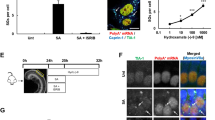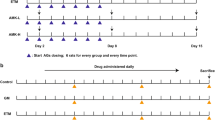Abstract
The use of aminoglycoside antibiotics is limited by ototoxicity that can produce permanent hearing loss. We report that concurrent administration of N–methyl–D–aspartate (NMDA) antagonists markedly attenuates both the hearing loss and destruction of cochlear hair cells in guinea pigs treated with aminoglycoside antibiotics. These findings indicate that aminoglycoside–induced hearing loss is mediated, in part, through an excitotoxic process. The high correlation (Spearman correlation coefficient: 0.928; P < 0.01) obtained between the relative cochleotoxicities of a series of aminoglycosides in humans and the potencies of these compounds to produce a polyamine–like enhancement of [3H]dizocilpine binding to NMDA receptors is consistent with this hypothesis, and provides a simple in vitro assay that can predict this aspect of aminoglycoside–induced ototoxicity.
This is a preview of subscription content, access via your institution
Access options
Subscribe to this journal
Receive 12 print issues and online access
$209.00 per year
only $17.42 per issue
Buy this article
- Purchase on Springer Link
- Instant access to full article PDF
Prices may be subject to local taxes which are calculated during checkout
Similar content being viewed by others
References
Begg, E.J. & Barclay, M.L. Aminoglycosides — 50 years on. Br. J. Clin. Pharmacol. 39, 597–603 (1995).
Brummett, R.E., Fox, K.E., Bendrick, T.W. & Himes, D.L. Ototoxicity of tobramycin, gentamicin, amikacin and sisomicin in the guinea pig. J. Antimicrob. Chemother. 4 (Suppl. A) 73–83 (1978).
Brummett, R.E. & Morrison, R.B. The incidence of aminoglycoside antibiotic-induced hearing loss. Arch. Otolaryngol Head Neck Surg. 116, 406–410 (1990).
Stringer, S.P., Meyerhoff, W.L. & Wright, C.G., Otoxicity. in Otolaryngology (eds. Paparella, M.M., Shumrick, D.A., Gluckman, J.L. & Meyerhoff, W.L.) 1653–1669 (Saunders, Philadelphia, 1991).
Hodges, G.R. Aminoglycoside toxicity. in The Aminoglycoside Antibiotics: A Guide to Therapy (eds. Barnes, W.G. & Hodges, G.R.) 153–179 (CRC Press, Boca Raton, Florida, 1984).
Kiang, N.Y.S., Liberman, M.C. & Levine, R.A. Auditory nerve activity in cats ex posed to ototoxic drugs and high-intensity sounds. Ann. Otol. Rhinol. Laryngol. 85, 752–768 (1976).
Schacht, J. Biochemical basis of aminoglycoside toxicity. Otolaryngol. Clin. North Am. 26, 845–856 (1993).
Lim, D.J. Effects of noise and ototoxic drugs at the cellular level in the cochlea. Am. J. Otolaryngol. 7, 73–99 (1986).
Puel, J.-L., Ladrech, R., Chabert, R., Pujol, R. & Eybalin, M. Electrophysiological evidence for the presence of NMDA receptors in the guinea pig cochlea. Hear. Res. 51, 255–264 (1991).
Safieddine, S. & Eybalin, M. Co-expression of NMDA and AMPA/kainate receptor mRNAs in cochlear neurones. NeuroReport 3, 1145–1148 (1992).
Usami, S., Matsubara, A., Fujita, S., Shinkawa, H. & Hayashi, M. NMDA (NMDAR1) and AMPA-type (GluR2/3) receptor subunits are expressed in the inner ear. NeuroReport 6, 1161–1164 (1995).
Pullan, L.M., Stumpo, R.J., Powel, R.J., Paschetto, K.A. & Britt, M. Neomycin is an agonist at a polyamine site on the N-methyl-D-aspartate receptor. J. Neurochem. 59, 2087–2093 (1992).
Choi, D.W. Excitotoxic cell death. J. Neurobiol. 23, 1261–1276 (1992).
Wong, E. et al. The anticonvulsant MK-801 is a potent N-methyl-D-aspartate antagonist. Proc. Natl. Acad. Sci. USA 83, 7104–7108 (1986).
Carter, C., Lloyd, K., Zivkovic, B. & Scatton, B. Ifenprodil and SL 82 0715 as cerebral anti-ischemic agents. III. Evidence for antagonistic effects at the polyamine modulatory site within the N-methyl-D-aspartate receptor complex. J. Pharmacol. Exp. Ther. 253, 475–482 (1990).
Oliveira, J.A.A. Methods for studying Ototoxicity. in Audiovestibular Toxicity of Drugs (ed. Oliveira, J.A.A.) 71–74 (CRC Press, Boca Raton, Florida, 1989).
Huang, J.-M., Money, M.K., Berlin, C.I. & Keats, B.J.B. Auditory phenotyping of heterozygous sound-responsive (+/dn) and deafness (dn/dn) mice. Hear. Res. 88, 61–64 (1995).
Brown, A.M., McDowell, B. & Forge, A. Acoustic distortion products can be used to monitor the effects of chronic gentamicin treatment. Hear. Res. 42, 143–156 (1989).
Henley, C.M. & Ryback, L.P. Ototoxicity in developing mammals. Brain Res. Rev. 20, 68–90 (1995).
Revai, K., Katona, G., Pytel, J., Czinner, A. & Pataki, L. Evaluation of hearing loss by means of inner ear acoustic emission in neonates with aminoglycoside. Orv. Hetil. 136, 2615–2618 (1995).
Lenoir, M. & Pujol, R. Age-related structural investigation of the Bronx waltzermutant mouse cochlea: Scanning and transmission electron microscopy. Hear. Res. 13, 123–134 (1984).
Chandler, P., Pennington, M., Maccecchini, M., Nashed, N. & Skolnick, P. Polyamine-like actions of peptides derived from conantokin-G, an NMDA antago nist. J. Biol. Chem. 268, 17173–17178 (1993).
Hashimoto, K., Mantione, C.R., Spada, M.R., Neumeyer, J.L. & London, E.D. Further characterization of [3H]ifenprodil binding in rat brain. Eur. J. Pharmacol. Mol. Pharmacol. Sect. 266, 67–77 (1994).
Akiyoshi, M., Yano, S. & Ikeda, T. Ototoxicity of spectinomycin. Jpn. J. Antibiot. 29, 771–782 (1976).
Reynolds, I.J. & Miller, R.J. Ifenprodil is a novel type of N-methyl-D-aspartate receptor antagonist: Interaction with polyamines. Mol. Pharmacol. 36, 758–765 (1989).
Eybalin, M. Neurotransmitters and neuromodulators in the mammalian cochlea. Physiol. Rev. 73, 309–373 (1993).
Benveniste, M. & Mayer, M.L. Multiple effects of spermine on N-methyl-D-aspartic acid receptor responses of rat cultured hippocampal neurons. J. Physiol. (Lond.) 464, 131–163 (1993).
Romano, C. & Williams, K. Modulation of NMDA receptors by polyamines. in The Neuropharmacology of Polyamines. (ed. Carter, C.) 81–106 (Academic Press, London, 1994).
Desrochers, C.S. & Schacht, J. Neomycin concentrations in inner ear tissues and other organs of the guinea pig after chronic drug administration. Acta Otolaryngol. 93, 233–236 (1982).
Reynolds, I.J. Arcaine uncovers dual interactions of polyamines with the N-methyl-D-aspartate receptor. J. Pharmacol. Exp. Ther. 256, 1001–1007 (1990).
Ernfors, P., Duan, M.L., ElShamy, W.M. & Canlon, B. Protection of auditory neurons from aminoglycoside toxicity by neurotrophin-3. Nature Med. 2, 463–467 (1996).
Scatton, B. et al. Neuroprotective potential of the polyamine site-directed NMDA receptor antagonists-ifenprodil and eliprodil. in Direct and Allosteric Control of Glutamate Receptors, (eds. Palfreyman, M.G., Reynolds, I.J., & Skolnick, P.) 139–154 (CRC Press, Boca Raton, Florida, 1994).
Gill, R., Foster, A.C. & Woodruff, G.N. MK-801 is neuroprotective in gerbils when administered during the postischaemic period. Neuroscience 3, 847–855 (1988).
Sveinbjornsdottir, S. et al. The excitatory amino acid antagonist D-CPP-ene (SDZ EAA-494) in patients with epilepsy. Epilepsy Res. 16, 165–174 (1993).
Cherkofsky, S.C. Aminocyclopropanecarboxylic acid: Mouse to man interspecies pharmacokinetic comparisons and allometric relationships. J. Pharm. Sci. 85, 1231–1235 (1995).
Patat, A. et al. Lack of amnestic psychotomimetic or impairing effect on psychomotor performance of eliprodil, a new NMDA antagonist. Int. Clin. Psychopharmacol. 9, 155–162 (1994).
Loscher, W., Nolting, B. & Honack, D. Evaluation of CPP, a selective NMDA antagonist, in various rodent models of epilepsy: Comparison of other NMDA antagonists, and with diazepam and phenobarbital. Eur. J. Pharmacol. 152, 9–17 (1988).
Oliveira, J.A.A. Aminoglycoside antibiotics — Neomycin. in Audiovestibular Toxicity of Drugs (ed. Oliveira, J.A.A.) 223–244 (CRC Press, Boca Raton, Florida, 1989).
Bamonte, F., Parravicini, L. & Arpini, A. Histological evaluation of ototoxic reaction due to some aminoglycoside antibiotics. Arch. Otorhinolaryngol. 228, 163–170 (1980).
Author information
Authors and Affiliations
Rights and permissions
About this article
Cite this article
Basile, A., Huang, JM., Xie, C. et al. N–Methyl–D–aspartate antagonists limit aminoglycoside antibiotic–induced hearing loss. Nat Med 2, 1338–1343 (1996). https://doi.org/10.1038/nm1296-1338
Received:
Accepted:
Issue Date:
DOI: https://doi.org/10.1038/nm1296-1338
This article is cited by
-
Assessment of cochlear toxicity in response to chronic 3,3′-iminodipropionitrile in mice reveals early and reversible functional loss that precedes overt histopathology
Archives of Toxicology (2021)
-
Adverse outcome pathway for aminoglycoside ototoxicity in drug-resistant tuberculosis treatment
Archives of Toxicology (2019)
-
Effect of intratympanic dimethyl sulphoxide (DMSO) in an in vivo model of cisplatin-related ototoxicity
European Archives of Oto-Rhino-Laryngology (2014)
-
Memantine’s action against aminoglycoside-induced ototoxicity
European Archives of Oto-Rhino-Laryngology (2014)
-
Hearing loss and tinnitus—are funders and industry listening?
Nature Biotechnology (2013)



